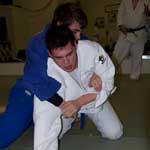 Are you interested in taking judo but don’t know much about it?
Are you interested in taking judo but don’t know much about it?
Watch Video
Judo History
Judo, which means “The Gentle Way”, is a Japanese martial art based upon the ancient techniques of jujutsu developed by Dr. Jigoro Kano in 1882. Dr. Kano, who had studied jujutsu in his youth, incorporated the best of these ancient techniques into the new art of Judo.
Judo Techniques
Judo is known for its spectacular throwing techniques but also includes numerous techniques for controlling an opponent while on the ground. Judo is often compared to freestyle wrestling, however, Judo retains many dangerous self-defense maneuvers. A good judoka, one who practices Judo, will first use timing and leverage to bring his opponent off balance and execute a throw. Once the judoka has thrown his opponent to the ground, he will use painful hold-down techniques, chokes, strangleholds, and armlocks to control and subdue the opponent. If the opponent does not surrender, he will either have his elbow joint dislocated by means of an armlock or will be rendered unconscious with a chokehold. A judoka first learns “ukemi”, the art of falling properly to avoid injury. All Judo practitioners wear a judogi and a belt. Judo is practiced on mats for safety.
Judo Philosophy
The main principles of Judo are “Maximum Efficiency” and “Mutual Welfare and Benefit.” The goal of maximum efficiency teaches the judoka to use the least amount of physical strength necessary to throw an opponent. This is accomplished by proper use of technique and timing. The goal of mutual welfare and benefit was an extension of Dr. Kano’s belief that Judo could help the individual become a better member of society. Dr. Kano felt that the personal discipline that Judo taught would extend beyond the dojo into daily life and could allow the judoka to become a more productive member of society.
Judo Terminology
Ashi Waza – Foot techniques
Dan – Black belt rank
Dojo – School or training hall for studying the way
Judoka – One who studies Judo
Judo – Gentle or flexible way
Obi – Judo belt
For a more complete list of Judo terminology, please click HERE
Other Aspects About Judo
People practice Judo for many different reasons such as exercise, self-defense, a social activity and for many practitioners Judo becomes a way of life. But if you ask most judoka why they train Judo, they will say that the practice Judo because it is fun. Judo is a great exercise routine. It promotes flexibility, develops speed and co-ordination, strengthens the cardiovascular system, and promotes balanced muscular development. Many Judo techniques can also be employed as a means of self-defense. The throws and chokeholds of Judo are particularly effective if one is forced to deal with an assailant. Judo ranks are awarded for developing proficiency in certain techniques and for regular practice. All judoka begin as white belts. Over time, they may earn a yellow belt, green belt, three degrees of brown belt, and finally a black belt.
** Video of New Rules of IJF 2018: https://www.bing.com/videos/search?q=neil+adams%2c+2018+rules&&view=detail&mid=C0C213B7BB62AE46A237C0C213B7BB62AE46A237&&FORM=VRDGAR